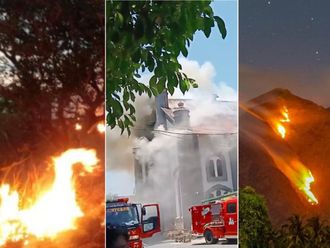Manila Confirmed deaths from the dawn flash flood that struck Davao City Wednesday has risen to 27 as local officials took stock of the devastation wrought by one of the worst calamity to hit country's biggest city.
According to the National Disaster Risk Reduction Management Council (NDRRMC) in Manila, a total 26 deaths have been recorded by authorities, all due to drowning.
Twenty-three of the deaths took place in the river-side village of Matina Crossing, two from Matina Pangi and one each from Talomo and Matina Aplaya.
Most of the fatalities were children and the elderly with the youngest, eight month-old John Cris Alvarez and the oldest, Antonio Inciso, 77.
Aside from the 27 confirmed deaths, four other flood victims remain missing.
NDRRMC said the estimated cost of damage has initially been pegged at P11 million (Dhs 252,000), although this approximation is expected to rise as authorities continue to gain access the affected areas.
A heavy downpour that started from 9 pm until early morning Wednesday had caused the Pangi and Matina Rivers to swell and in some residential areas, the floodwaters reach a depth of up to three metres.
Reports said that the extent of damage could have been greater had Davao City Mayor Sara Duterte-Carpio and local disaster management authorities not reacted swiftly. During the flashflood, the army, navy, coast guard and the national police scrambled personnel to conduct rescue and evacuation operations.
The military maintains one of its biggest base in Davao City, Camp Panacan.
An estimated 25,000 families or 125,000 residents of the villages of Matina Pangi, Matina Crossing, Matina Aplaya, Matina Balusong and Talomo were affected by the flooding.
According to Department of Social Welfare and Development Secretary Corazon Soliman, 7,350 families are temporarily sheltered ub four evacuation centres in Davao City.
In the wake of the flooding that devastated large areas of Davao City, Senator Loren Legarda urged local government units (LGUs) to exhaust all means to improve flood mitigation measures and lessen, if not prevent altogether, damages and casualties from floods.
Legarda, Chair of the Senate Committee on Climate Change, said: "Many of our LGUs have already started investing in flood control infrastructure, such as river embankments, pumping stations, flood walls, drainage systems, storm drains, canals, and flood retention areas. However, this must be done in tandem with non-structural flood mitigation measures,"
Legarda explained that LGUs, especially the villages, must also set-up early warning systems, create a team of flood volunteers that can be mobilized during such emergency situations, and improve their land use plans.
"LGUs must integrate flood mitigation tools in their CLUPs (Comprehensive Land Use Plans). It is not enough to mention that they are flood-prone. They must assess the volume of floodwaters, how often flooding occurs and how much damage they have suffered from the past so that their CLUPs are responsive to their flood exposure and vulnerability issues," she stressed.












